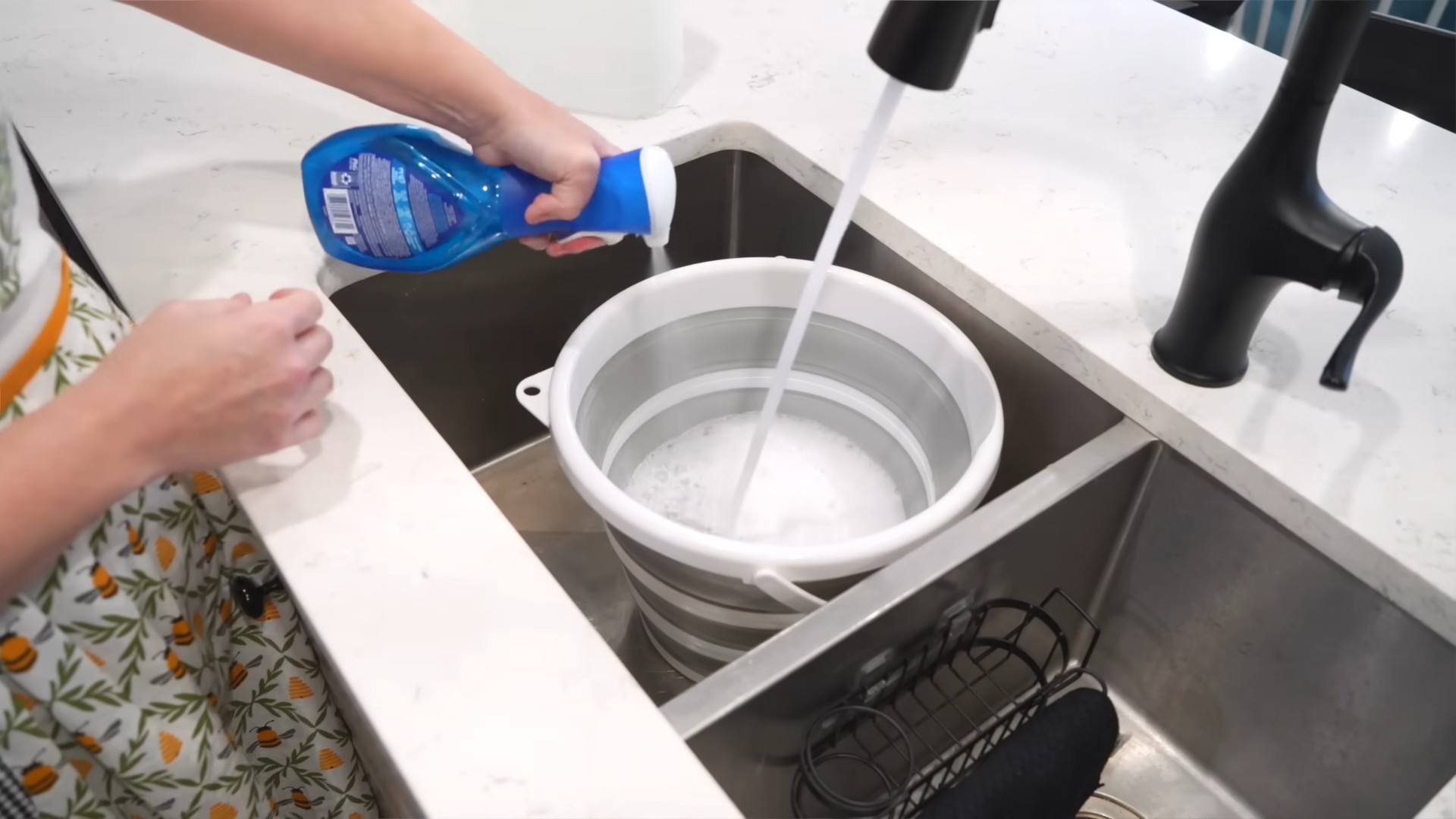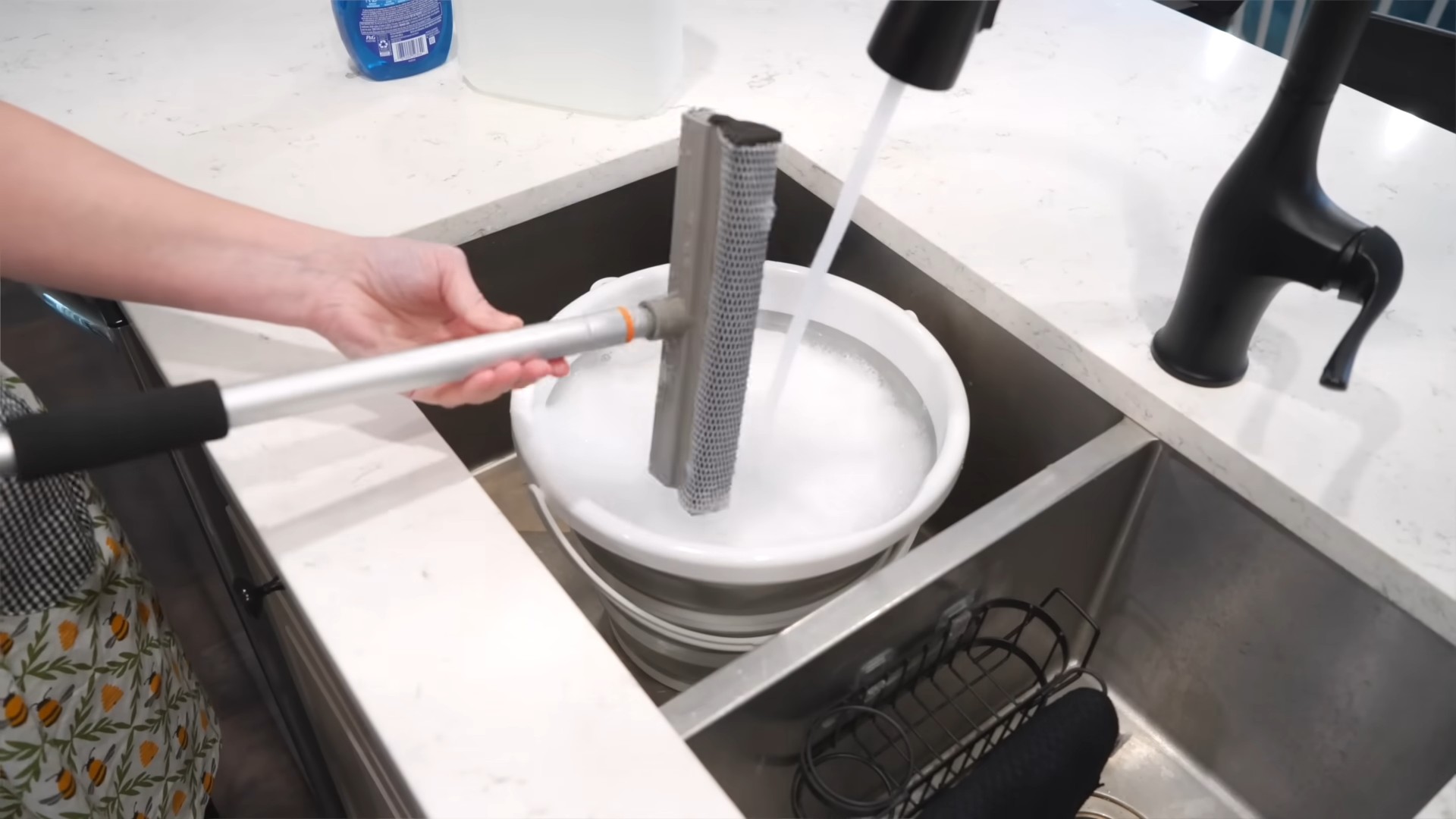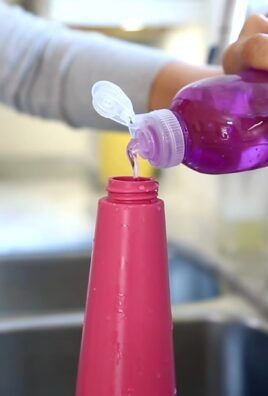DIY streak-free glass cleaner is the holy grail for anyone who’s ever battled smudges and streaks on their windows and mirrors! Let’s be honest, store-bought glass cleaners can be expensive and often leave behind a frustrating film. But what if I told you that the secret to sparkling, crystal-clear glass is probably already hiding in your pantry?
The quest for perfectly clean glass has been around for ages! Think about the grand palaces and cathedrals throughout history – their shimmering windows were a testament to both wealth and meticulous cleaning practices. While they might have used different methods back then, the desire for a pristine view remains the same.
In today’s busy world, who has time to spend hours scrubbing? That’s where this DIY trick comes in. I’m going to share a simple, effective, and budget-friendly recipe for DIY streak-free glass cleaner that will transform your cleaning routine. Not only will you save money, but you’ll also know exactly what ingredients are going onto your surfaces, making it a safer and more eco-conscious choice for your home and family. Get ready to say goodbye to streaks and hello to sparkling clean glass!

DIY Streak-Free Glass Cleaner: Say Goodbye to Smudges!
Okay, let’s be honest, store-bought glass cleaner can be a real letdown. You spray, you wipe, and you’re left with…streaks! It’s frustrating, right? Well, I’ve got the perfect solution: a homemade glass cleaner that’s not only incredibly effective but also super cheap and eco-friendly. Trust me, once you try this, you’ll never go back to the store-bought stuff.
What You’ll Need: The Magic Ingredients
Before we dive into the mixing, let’s gather our supplies. This recipe uses simple ingredients you probably already have in your pantry!
* **White Vinegar:** This is the star of the show! Vinegar’s acidity cuts through grease and grime like a champ.
* **Distilled Water:** Using distilled water is key to avoiding mineral deposits that can cause streaks. Tap water can sometimes leave a residue.
* **Rubbing Alcohol (Isopropyl Alcohol):** This helps the cleaner evaporate quickly, preventing streaks.
* **Essential Oil (Optional):** While not essential for cleaning power, a few drops of your favorite essential oil will add a pleasant scent. I personally love lemon, lavender, or eucalyptus.
* **Spray Bottle:** A clean, empty spray bottle is a must. I recommend a dark-colored bottle to protect the essential oils from light degradation, but any spray bottle will work.
* **Microfiber Cloths:** These are your best friends for streak-free cleaning. Avoid paper towels, as they can leave lint behind.
Step-by-Step Instructions: Mixing the Perfect Solution
Now for the fun part! Let’s mix up our streak-free glass cleaner.
1. **Prepare Your Spray Bottle:** Make sure your spray bottle is clean and dry. Any residue inside could contaminate your cleaner.
2. **Add the Vinegar:** Pour 1/4 cup of white vinegar into the spray bottle.
3. **Add the Rubbing Alcohol:** Next, add 1/4 cup of rubbing alcohol to the bottle.
4. **Top with Distilled Water:** Fill the rest of the spray bottle with distilled water, leaving a little space at the top.
5. **Add Essential Oil (Optional):** If you’re using essential oil, add 5-10 drops to the mixture. Remember, a little goes a long way!
6. **Shake it Up!:** Secure the spray nozzle and shake the bottle gently to combine all the ingredients.
Cleaning Like a Pro: Application Tips and Tricks
Okay, you’ve got your amazing homemade glass cleaner. Now, let’s talk about how to use it to achieve those sparkling, streak-free results we’re after.
1. **Spray Sparingly:** Don’t over-saturate the glass. A light mist is all you need. Too much cleaner can actually contribute to streaks.
2. **Wipe with a Microfiber Cloth:** Fold your microfiber cloth into quarters. This gives you multiple clean surfaces to work with.
3. **Wipe in One Direction:** Wipe the glass in a consistent direction, either horizontally or vertically. Avoid circular motions, as they can leave streaks.
4. **Flip and Buff:** Once you’ve wiped the entire surface, flip the cloth to a clean, dry section and buff the glass to remove any remaining moisture.
5. **Repeat if Necessary:** For heavily soiled glass, you may need to repeat the process.
Where to Use Your Homemade Glass Cleaner: Beyond Windows
This cleaner isn’t just for windows! It’s incredibly versatile and can be used on a variety of surfaces.
* **Mirrors:** Say goodbye to smudged mirrors! This cleaner works wonders on bathroom and vanity mirrors.
* **Glass Shower Doors:** Keep your shower doors sparkling clean and free of soap scum.
* **Car Windows:** Use this cleaner to keep your car windows clear and streak-free.
* **Stainless Steel Appliances:** Believe it or not, this cleaner can also be used to polish stainless steel appliances. Just spray a small amount onto a microfiber cloth and wipe.
* **Electronics Screens (Use with Caution):** While some people use vinegar-based cleaners on electronics screens, I recommend being very cautious. Always spray the cleaner onto a microfiber cloth, *never* directly onto the screen. And test a small, inconspicuous area first. For delicate screens, a specialized electronics cleaner is always the safest option.
Troubleshooting: Common Issues and Solutions
Even with the best recipe, sometimes things don’t go exactly as planned. Here are some common issues you might encounter and how to fix them.
* **Streaks:** If you’re still seeing streaks, try using a different microfiber cloth. Sometimes, the cloth itself can be the culprit. Also, make sure you’re not using too much cleaner.
* **Smell:** The vinegar smell can be a bit strong at first, but it dissipates quickly. If you’re sensitive to smells, add more essential oil or open a window for ventilation.
* **Residue:** If you’re noticing a residue, it could be due to hard water. Make sure you’re using distilled water.
* **Cloudiness:** If your cleaner looks cloudy, it could be due to the essential oil not fully dissolving. Try shaking the bottle more vigorously.
Advanced Tips and Tricks for Sparkling Results
Want to take your glass cleaning game to the next level? Here are some extra tips and tricks I’ve learned over the years.
1. **Clean on a Cloudy Day:** Avoid cleaning windows in direct sunlight, as the cleaner can dry too quickly and leave streaks. A cloudy day is ideal.
2. **Pre-Clean Heavily Soiled Glass:** If your windows are particularly dirty, pre-clean them with a mixture of warm water and dish soap before using the glass cleaner. This will remove any loose dirt and debris.
3. **Use a Squeegee:** For large windows or shower doors, a squeegee can be a game-changer. After spraying the cleaner, use the squeegee to remove the excess liquid in overlapping strokes. Then, wipe the blade with a clean microfiber cloth after each stroke.
4. **Clean Your Microfiber Cloths Regularly:** Dirty microfiber cloths can actually contribute to streaks. Wash your cloths regularly in hot water with a mild detergent. Avoid using fabric softener, as it can leave a residue.
5. **Experiment with Different Essential Oils:** Don’t be afraid to experiment with different essential oils to find your favorite scent. Citrus oils like lemon and orange are great for cutting through grease, while lavender and eucalyptus have a more calming effect.
6. **Adjust the Recipe to Your Needs:** This recipe is a great starting point, but you can adjust it to suit your specific needs. For example, if you live in an area with hard water, you might want to increase the amount of vinegar.
Why This DIY Cleaner is Better Than Store-Bought
I know, I know, it’s tempting to just grab a bottle of glass cleaner off the shelf at the store. But trust me, making your own is so much better for several reasons:
* **It’s Cheaper:** The ingredients for this DIY cleaner are incredibly inexpensive, especially if you already have them on hand. You’ll save a ton of money compared to buying store-bought cleaners.
* **It’s Eco-Friendly:** Store-bought glass cleaners often contain harsh chemicals that can be harmful to the environment. This DIY cleaner is made with natural ingredients that are biodegradable and safe for your family and pets.
* **It’s Customizable:** You can customize this cleaner to your liking by adding your favorite essential oils or adjusting the recipe to suit your specific needs.
* **It’s More Effective:** In my experience, this DIY cleaner is actually more effective than many store-bought cleaners. It cuts through grease and grime without leaving streaks.
* **You Know What’s In It:** With a DIY cleaner, you know exactly what you’re putting on your surfaces. No hidden chemicals or mystery ingredients!
Safety First: Important Precautions
While this DIY glass cleaner is made with natural ingredients, it’s still important to take some safety precautions:
* **Keep Out of Reach of Children and Pets:** Although the ingredients are relatively safe, it’s still best to keep the cleaner out of reach of children and pets.
* **Avoid Contact with Eyes:** If the cleaner gets in your eyes, rinse immediately with plenty of water.
* **Test on an Inconspicuous Area First:** Before using the cleaner on a new surface, test it on a small, inconspicuous area to make sure it doesn’t cause any damage or discoloration.
* **Don’t Mix with Other Cleaners:** Never mix this cleaner with other cleaning products, as this could create harmful fumes.
* **Store in a Properly Labeled Container:** Make sure to label your spray bottle clearly so that you don’t accidentally mistake it for something else.
So there you have it! My ultimate guide to making your own streak-free glass cleaner. I hope you give it a try and see for yourself how amazing it is. Happy cleaning!

Conclusion
So, there you have it! Ditching the store-bought glass cleaner and embracing this simple, effective DIY streak free glass cleaner recipe is more than just a cost-saving measure; it’s a step towards a healthier home and a sparkling clean view. We’ve walked you through the process, highlighting the ease and accessibility of the ingredients. But why is this DIY approach a must-try?
Firstly, you’re in complete control. You know exactly what’s going into your cleaner, eliminating harsh chemicals and artificial fragrances that can irritate sensitive skin or trigger allergies. This is especially important for households with children or pets. Secondly, the results speak for themselves. This homemade solution cuts through grime, grease, and fingerprints, leaving your windows, mirrors, and glass surfaces gleaming without those frustrating streaks. The vinegar’s acidity is a natural degreaser and disinfectant, while the rubbing alcohol helps the solution evaporate quickly, preventing streaks.
But the beauty of DIY lies in its adaptability. Feel free to experiment with variations to tailor the cleaner to your specific needs and preferences. For example, if you’re not a fan of the vinegar scent, you can infuse your vinegar with citrus peels for a few days before using it in the recipe. Lemon, orange, or grapefruit peels will add a subtle, refreshing fragrance. Alternatively, add a few drops of your favorite essential oil, such as lavender, eucalyptus, or tea tree oil, for an aromatherapy boost while you clean. Just be mindful of using essential oils safely, especially around pets.
Another variation involves adjusting the ratio of ingredients. If you find the vinegar scent too strong, you can reduce the amount slightly and increase the water. Conversely, if you’re dealing with particularly stubborn grime, you can increase the vinegar concentration. Remember to test your solution on a small, inconspicuous area first to ensure it doesn’t damage the surface.
For those with hard water, consider using distilled water instead of tap water to further minimize the risk of streaks. Hard water contains minerals that can leave residue on glass surfaces. Distilled water is free of these minerals, resulting in a cleaner, more streak-free finish.
Beyond windows and mirrors, this DIY streak free glass cleaner is also fantastic for cleaning shower doors, glass stovetops, and even stainless steel appliances. Just be sure to avoid using it on porous surfaces like marble or granite, as the vinegar can etch the stone.
We’re confident that once you try this DIY streak free glass cleaner, you’ll be amazed by the results and the simplicity of the process. It’s a sustainable, cost-effective, and healthier alternative to commercial cleaners.
So, what are you waiting for? Gather your ingredients, mix up a batch, and experience the joy of sparkling clean glass without the streaks or the harsh chemicals. We encourage you to try this DIY trick and share your experiences with us! Let us know in the comments below how it worked for you, what variations you tried, and any tips you have to share. We can’t wait to hear from you! Share your before and after photos on social media using #DIYStreakFreeCleaner and inspire others to embrace the power of homemade cleaning solutions. Let’s create a community of clean, healthy, and sustainable homes, one sparkling window at a time!
Frequently Asked Questions (FAQ)
Why should I make my own glass cleaner instead of buying it from the store?
There are several compelling reasons to switch to a DIY glass cleaner. Firstly, you have complete control over the ingredients, avoiding harsh chemicals, artificial fragrances, and potentially harmful additives found in many commercial cleaners. This is especially beneficial for individuals with sensitivities, allergies, or concerns about the environmental impact of chemical products. Secondly, it’s significantly more cost-effective. The ingredients required for this DIY recipe are typically inexpensive and readily available in most households. Finally, it’s a sustainable choice, reducing plastic waste from disposable spray bottles and minimizing your carbon footprint.
What if I don’t have rubbing alcohol? Can I substitute it with something else?
While rubbing alcohol (isopropyl alcohol) is the preferred ingredient for its quick-drying properties and streak-free finish, you can try substituting it with vodka (the higher the proof, the better) in a pinch. Vodka also contains alcohol, which helps the solution evaporate quickly. However, be aware that the results may not be quite as streak-free as with rubbing alcohol. Avoid using other types of alcohol, such as denatured alcohol, as they may contain additives that can leave residue on glass surfaces.
The vinegar smell is too strong. How can I reduce it?
The vinegar scent is a common concern for those new to DIY cleaning. Fortunately, there are several ways to minimize it. As mentioned earlier, you can infuse your vinegar with citrus peels for a few days before using it in the recipe. This will impart a subtle, refreshing fragrance. Alternatively, add a few drops of your favorite essential oil, such as lavender, lemon, or eucalyptus, to the spray bottle. The essential oil will not only mask the vinegar scent but also provide aromatherapy benefits. You can also reduce the amount of vinegar in the recipe and increase the water, but be mindful that this may slightly reduce the cleaning power. Ensure proper ventilation while cleaning to further minimize the lingering scent.
Will this DIY glass cleaner damage tinted windows?
While this DIY glass cleaner is generally safe for most glass surfaces, it’s always best to test it on a small, inconspicuous area of your tinted windows first. Some window tints are delicate and may be affected by the acidity of the vinegar. If you notice any discoloration or damage after testing, discontinue use. For tinted windows, you might consider using a milder solution with less vinegar or opting for a commercial glass cleaner specifically designed for tinted windows.
How long will this DIY glass cleaner last?
This DIY glass cleaner has a relatively long shelf life. Because of the vinegar and alcohol content, it acts as a preservative. You can store it in a spray bottle for several months without any significant degradation in quality. However, it’s best to store it in a cool, dark place to prevent the essential oils (if used) from losing their potency. If you notice any cloudiness or separation, simply shake the bottle well before using.
Can I use this cleaner on my car windows?
Yes, this DIY glass cleaner is safe to use on your car windows. However, avoid spraying it directly onto the car’s paint, as the vinegar could potentially damage the finish over time. Instead, spray the cleaner onto a microfiber cloth and then wipe the windows. Be sure to use a clean, lint-free microfiber cloth to prevent streaks.
What type of cloth should I use to wipe the glass?
The type of cloth you use is crucial for achieving a streak-free finish. Microfiber cloths are the best choice for cleaning glass surfaces. They are highly absorbent, lint-free, and effectively lift dirt and grime without scratching the glass. Avoid using paper towels, as they can leave behind lint and streaks. You can also use a squeegee for larger surfaces like windows and shower doors.
How often should I clean my windows with this DIY cleaner?
The frequency of cleaning depends on your environment and personal preferences. In general, cleaning your windows every few weeks is sufficient to maintain a clear view. However, if you live in a dusty or polluted area, you may need to clean them more frequently.
Can I use this cleaner on my electronic screens (TV, computer, phone)?
No, this DIY glass cleaner is not recommended for use on electronic screens. The vinegar and alcohol can damage the delicate coatings and components of these screens. Instead, use a cleaner specifically designed for electronic screens, or simply wipe them with a dry, lint-free microfiber cloth.
What if I still see streaks after cleaning?
If you’re still experiencing streaks after cleaning, there are a few possible reasons. First, ensure that you’re using a clean, lint-free microfiber cloth. A dirty or worn-out cloth can leave behind residue. Second, make sure you’re not using too much cleaner. A light mist is all you need. Over-saturating the surface can lead to streaks. Finally, try buffing the glass with a dry microfiber cloth after cleaning to remove any remaining residue. If you have hard water, consider using distilled water in your DIY cleaner.




Leave a Comment